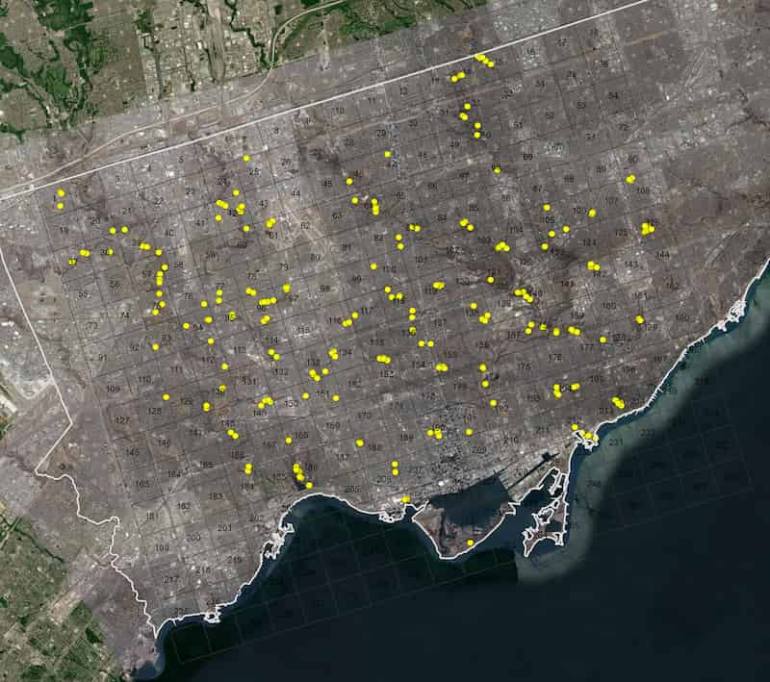Expanding cities mean that pollinators have to adapt to survive in new environments. City planners increasingly recognise the importance of accomodating pollinators in urban locations, but what features aid or harm pollinators in the city? Ida Conflitti and colleagues surveyed Toronto to see where the Common Eastern Bumblebee, Bombus impatiens, could find a home and where they were sparse. They found that not all urban space was equal and have suggestions on improving urban habitats for insects.

The team divided the city into 270 grid cells of 2 × 2 kilometres. They then selected random cells, and between July and October 2016, they went looking for worker bees. A collector would have up to two hours, or sixty specimens, to find bees before moving to an adjacent cell. The collected bees were unlucky, as they’d end the day in deep freeze at −80° centigrade.
The reason that the surveyors needed a lot of bees was for the DNA. The team genotypes the bees to identify which bees came from the same colony. If the scientists had a few bees from the same colony, then the distance between related bees could be used to calculate the average foraging distance for the bumblebees.
The basic results correlated with previous studies. Paved surfaces had a negative effect on colonies, while green space for foraging had a positive impact. This seems a lot of work to confirm what we already know, but it also shows that anything else they found was likely to be accurate rather than the result of some statistical freak.

Another question they looked at was the role of the “luxury effect“. Do wealthier neighbourhoods have better gardens for pollinators? This has been found to be the case in the UK. In contrast, in Chicago, there was no significant difference between neighbourhoods. Conflitti and colleagues found that there may be a difference between North American and British planning. In their article, they write: “Our study in Toronto appears to be more in line with Chicago (both in North America), where income did not appear to influence bumblebee habitat quality. We think this bodes well for ensuring that Toronto’s diverse community benefits equally from the pollination services that bumblebees, and possibly other wild pollinators, provide. Lack of a “luxury effect” in Toronto also implies that the opportunities for observing bumblebees and engaging in bumblebee conservation is—in theory—not restricted to a subset of Toronto’s population.”
Important features in the landscape were roads, railways and houses. Road and railways acted as barriers. Despite being able to fly over the roads and railways, bees prefered not to do so. These barriers increased forage distances as the bees tended not to hop over to flowers on the other side of the barrier. Conflitti and colleagues were surprised that housing density in a grid cell had a positive effect. They state in their article: “This likely reflects that the type of urbanization matters. In other words, in the absence of city parks or watershed forests, urban areas with a higher density of single or multiple family houses likely provide better foraging opportunities for bumblebees relative to urban areas with a high density of multilevel buildings. Houses in Toronto typically have a front yard and a back yard, which can provide some foraging opportunities for bumblebees throughout their active flight season (e.g., flowering trees, small-scale gardens, and weeds).”
“While green space is important for bumblebees, our study indicated that natural/functional green spaces, such as city parks and forests, were often beneficial relative to aesthetic green spaces, such as lawns.”
The authors acknowledge that not all pollinators are Bombus impatiens but argue that the bee is a good stand-in for a wider study of pollinators. With this in mind, Conflitti and colleagues make a couple of suggestions to improve the urban environment for pollinators. First, they say that the conversion of paved surfaces to functional green spaces such as parks and meadows is likely to significantly influence the quality of pollinator habitats in Toronto. They also say it has to be the right kind of green space. Converting aesthetic green spaces such as lawns into more functional natural green spaces like flowering meadows would reduce foraging distances. As foraging is expensive in energy, reducing the average forage distance would greatly improve habitats for bumblebees.
ORIGINAL ARTICLE
Conflitti IM, Imrit MA, Morrison B, Sharma S, Colla SR, Zayed A. (2022) Bees in the six: Determinants of bumblebee habitat quality in urban landscapes. Ecology and Evolution. https://doi.org/10.1002/ece3.8667





